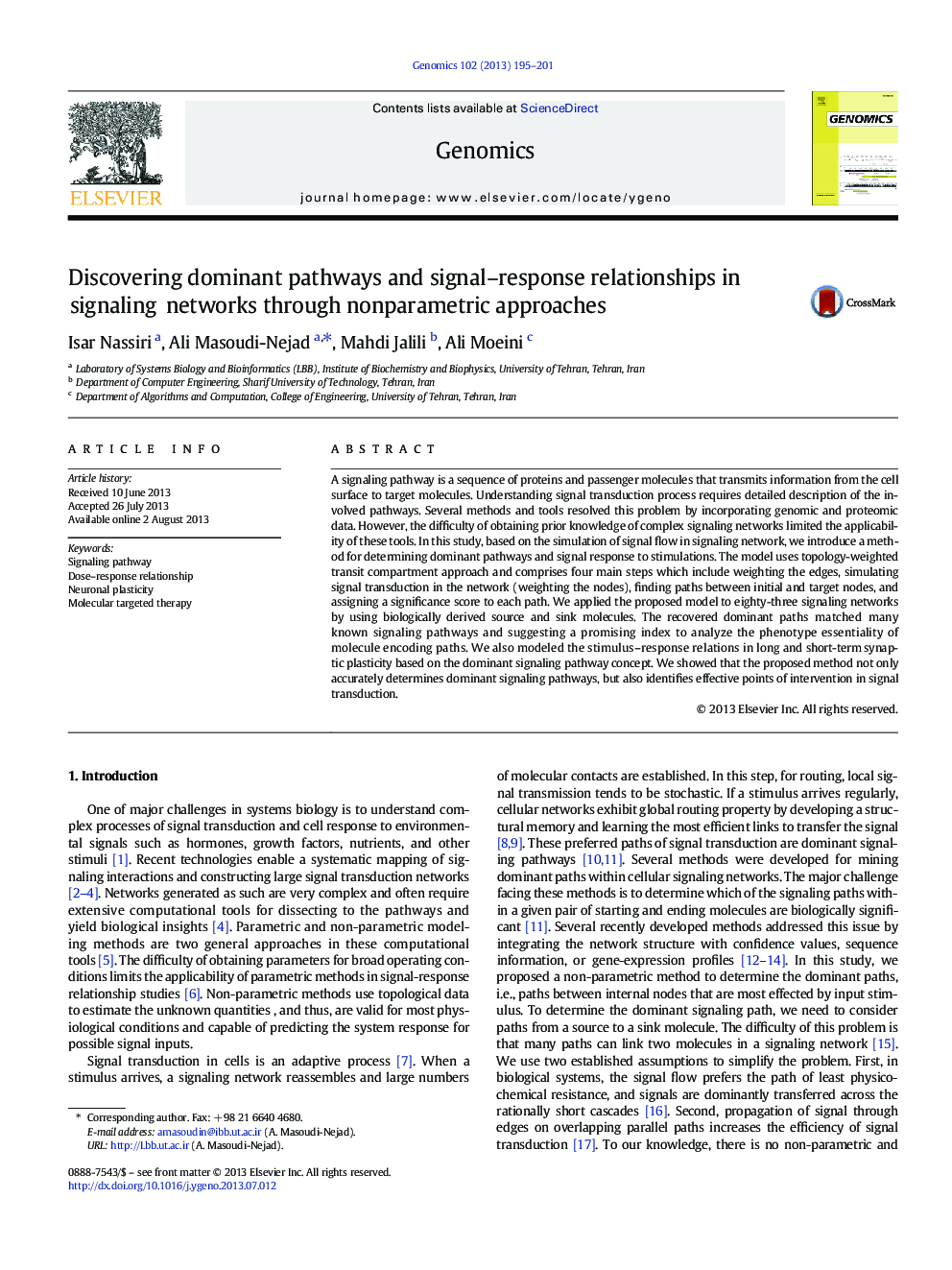| کد مقاله | کد نشریه | سال انتشار | مقاله انگلیسی | نسخه تمام متن |
|---|---|---|---|---|
| 5907773 | 1160871 | 2013 | 7 صفحه PDF | دانلود رایگان |
عنوان انگلیسی مقاله ISI
Discovering dominant pathways and signal-response relationships in signaling networks through nonparametric approaches
ترجمه فارسی عنوان
کشف مسیرهای غالب و روابط سیگنال پاسخ در شبکه های سیگنال از طریق روش های غیر پارامتری
دانلود مقاله + سفارش ترجمه
دانلود مقاله ISI انگلیسی
رایگان برای ایرانیان
کلمات کلیدی
مسیر سیگنالینگ، روابط پاسخ مثبت، پلاستیک نوری درمان موثر و موثر
ترجمه چکیده
مسیر سیگنالینگ یک دنباله ای از پروتئین ها و مولکول های مسافری است که اطلاعات را از سطح سلول به مولکول های هدف انتقال می دهد. درک فرآیند انتقال سیگنال نیازمند توضیح دقیق مسیرهای درگیر است. چندین روش و ابزار حل این مشکل را با استفاده از داده های ژنوم و پروتئومیک. با این حال، مشکل دریافت دانش قبلی از شبکه های سیگنال پیچیده، کاربرد این ابزار ها را محدود می کند. در این مطالعه، بر اساس شباهت جریان سیگنال در شبکه سیگنالینگ، ما یک روش برای تعیین مسیرهای غالب و پاسخ سیگنال به تحریک ها را معرفی می کنیم. این مدل با استفاده از رویکرد توزیع توابع توپولوژی و چهار مرحله اصلی شامل وزن گذاری لبه ها، شبیه سازی انتقال سیگنال در شبکه (وزن گره ها)، پیدا کردن مسیر بین گره های اولیه و هدف و تعیین امتیاز قابل توجهی در هر مسیر است. ما مدل پیشنهادی را به هشتاد و سه شبکه سیگنالینگ با استفاده از مولکول های منبع و غرقابی مشتق شده از بیولوژیکی اعمال کردیم. مسیرهای غالب بهبود یافته با بسیاری از مسیرهای سیگنال شناخته شده مطابقت داده شده و پیشنهاد یک شاخص امیدوار کننده برای تجزیه و تحلیل ضرورت فنوتیپ مسیرهای رمزگذاری مولکول را نشان می دهد. ما همچنین روابط تحریک-پاسخ در مقیاس انعطاف پذیری سیناپسی طولانی و کوتاه مدت را بر اساس مفهوم راهبرد سیگنال غالب تعیین کردیم. ما نشان دادیم که روش پیشنهادی نه تنها دقیق مسیرهای سیگنالینگ غالب را تعیین می کند بلکه نقاط موثر مداخله در انتقال سیگنال را مشخص می کند.
موضوعات مرتبط
علوم زیستی و بیوفناوری
بیوشیمی، ژنتیک و زیست شناسی مولکولی
ژنتیک
چکیده انگلیسی
A signaling pathway is a sequence of proteins and passenger molecules that transmits information from the cell surface to target molecules. Understanding signal transduction process requires detailed description of the involved pathways. Several methods and tools resolved this problem by incorporating genomic and proteomic data. However, the difficulty of obtaining prior knowledge of complex signaling networks limited the applicability of these tools. In this study, based on the simulation of signal flow in signaling network, we introduce a method for determining dominant pathways and signal response to stimulations. The model uses topology-weighted transit compartment approach and comprises four main steps which include weighting the edges, simulating signal transduction in the network (weighting the nodes), finding paths between initial and target nodes, and assigning a significance score to each path. We applied the proposed model to eighty-three signaling networks by using biologically derived source and sink molecules. The recovered dominant paths matched many known signaling pathways and suggesting a promising index to analyze the phenotype essentiality of molecule encoding paths. We also modeled the stimulus-response relations in long and short-term synaptic plasticity based on the dominant signaling pathway concept. We showed that the proposed method not only accurately determines dominant signaling pathways, but also identifies effective points of intervention in signal transduction.
ناشر
Database: Elsevier - ScienceDirect (ساینس دایرکت)
Journal: Genomics - Volume 102, Issue 4, October 2013, Pages 195-201
Journal: Genomics - Volume 102, Issue 4, October 2013, Pages 195-201
نویسندگان
Isar Nassiri, Ali Masoudi-Nejad, Mahdi Jalili, Ali Moeini,
